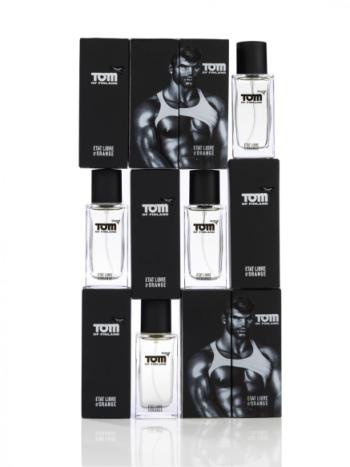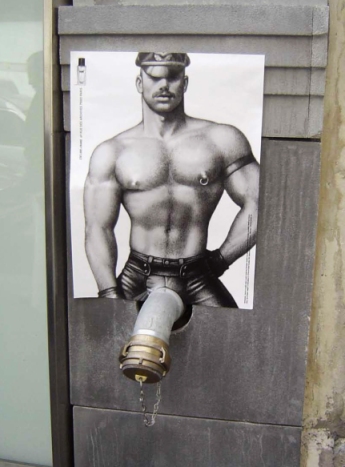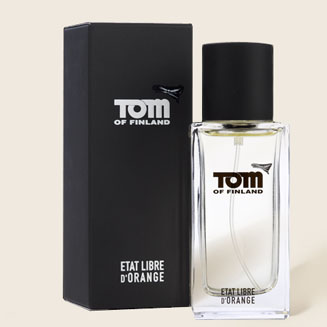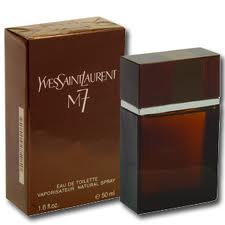Appearances can be deceiving. The impact of the unexpected, of a surprise twist, is one of the reasons why the thematic device of “appearance versus reality” has been such a great constant in literature. From the classical comedies of Rome’s Plautus to such Shakespearean tragedies as Othello, and all the way up to today’s Harry Potter, the unexpected, ironic twist has had power.
What works so well in literature is not, however, always so effective in perfume. Here, appearances can lead to certain expectations and a crushing, critical sense of disappointment as a result. To wit, Chanel‘s recent Coco Noir which has been panned as neither a real relative of Coco nor anything noir. (It isn’t.) Similarly vaunted expectations must have come with Tom of Finland (ToF), a
unisex scent by the avant-garde, perfume house, État Libre d’Orange (hereinafter ELdO). And there is similar disappointment. This is not a terrible, ghastly scent. In fact, it is extremely whimsical. You might even say that it is intentionally fun, deliberately misleading for artistic reasons, and performance art. To that extent — and on an intellectual, artistic level — I admire its philosophy and whimsy. But I cannot consider it as more than a novelty act, and I certainly would never wear it.
The perfume is inspired by the life, art and philosophy of an actual person, Tom of Finland, the pseudonym of a Finnish artist called Touko Laaksonen (1920-1991). Wikipedia tells me that Tom (as I shall call him to avoid confusion with his fragrance) was an artist
notable for his stylized androerotic and fetish art and his influence on late twentieth century gay culture. He has been called the “most influential creator of gay pornographic images” by cultural historian Joseph W. Slade. Over the course of four decades he produced some
3500 illustrations, mostly featuring men with exaggerated primary and secondary sex traits with tight or partially removed clothing. [… He published] explicit drawings and stylized his figures’ fantastical aspects with exaggerated physical aspects, particularly their genitals and muscles. He is best known for works that focused on homomasculine archetypes such as lumberjacks, motorcycle policemen, sailors, bikers, and leathermen.
… There is considerable argument over whether his
depiction of ‘supermen’ (male characters with huge sexual organs and muscles) is facile and distasteful, or whether there is a deeper complexity in the work which plays with and subverts those stereotypes. For example, some critics have noted examples of apparent tenderness between traditionally tough, masculine characters, or playful smiles in sado-masochistic scenes. [Others, however, call his work] …’masturbation pieces.’
Tom died in 1991 and the Tom of Finland Foundation was established, “dedicated to protecting and preserving erotic art and erotic arts education.” In that vein, they commissioned ELdO to make a perfum representing the artist’s work. The result was released in 2008.
According to ELdO’s website, there is a story and mood that goes with the perfume:
The water slips over him as if sliding down a marble rock, sinking into the grooves of his muscles, vanishing into his pores. This is fresh, pure water, with top notes of aldehydes and lemon, a water that washes away the sins of the night and leaves the skin luminous. Tom of Finland feels clean, like a shaving from a cake of soap. It is an ode to the beauty of the male body and to the radiance of the natural self. For this man, clothing becomes a jewel-case that serves to reveal the true erotic power of the flesh. Tom of Finland is a breath of fresh air, offering unrestricted access to the immense outdoors, the depths of the forest, with notes of birch leaves, cypress, galbanum and pine at its heart. Straight, gay… these words are irrelevant here. Tom of Finland is beyond sexuality – he is sex, in all its fullness and magnitude, open and erect. Fantasy clings to him like his leather jacket, with suede, musk, and ambergray in the base notes. His belt is fastened with an accord of pepper and spicy-fresh saffron, tangled with a blond suede sensuality on a vanilla bed of tonka bean and iris. This is a man who wants to play, to love, to die and be reborn, again and again.Tom of Finland is a tribute to tomorrow’s glorious possibilities.
This is a fresh, pure water that can wash away the sins of the night. Clothing becomes merely ornamental, an insignificant wrapping paper that only serves to cloak the true erotic power of the flesh. This is a man who wants to play, to love, to ravish, and to be free of all inhibitions. Tom is sex. [Emphasis in the original.]
What a story! I have to say, on a purely artistic, theoretical and intellectual level, I’m rather impressed. Alas, if only the result matched the story. One should not judge a perfume by its rather lyrical, romantic story or by its marketing…
The notes in the perfume are listed as:
Aldehydes, lemon, birch leaves, pine, safraleine, pepper, cypress, galbanum, geranium, vanilla, tonka bean, orris, vetiver, pyrogened styrax, suede, musk, ambergray.
As the extremely amusing, snarky and snide review in Now Smell This (NST) underscored: “Men, as you spray on Tom of Finland don’t be afraid; keep in mind it ‘has no sexual orientation’. ”
I think women need to heed the same lesson. In fact, they should ignore all references to this as a men’s fragrance because it is most definitely the most feminine “leather” I have ever smelled! I put “leather” in quotes because, on me, this is cherry-vanilla soda with a massive dose of white confectioner’s sugar and a faint hint of suede. But we should start at the beginning.
ToF opens on me with a strong burst of citrus and soap. It’s mostly lemon with some orange and a hefty dose of soap from the aldehydes. (You can read more about aldehydes along with many of the other notes in ToF in my Glossary.) A minute in, I smell the leather. It is just like the leather in a new leather jacket, except that it turns into lemon-leather within seconds. And, seconds after that, it turns into vanilla-lemon-leather with a hint of some sweet fruit that — to my utterly disbelieving nose — really smells like cherry. I take a second, then a third look at the notes. Nope, no cherry listed. No fruit at all, in fact.
So, I turn to Perfumes: The A-Z Guide by Luca Turin and Tania Sanchez because I know that they’ve given this 4-stars. (Something which, by the way, underscores my daily reminder about how often and intensely I disagree with the honourable Luca Turin!) In the book, Ms. Sanchez classifies ToF as a “saffron cologne” and writes predominantly about how the use of a new saffron synthetic from Givaudan has been playing “understudy” to sandalwood. The latter is now so scarce that its cost is essentially outside the reach of most commercial perfumers. As a result, they have essentially turned to the “dusty-milky” scent of saffron, via Safraleine, to replicate some of the notes. Ms. Sanchez concludes by saying: “[t]his saffron-lemon cologne has the unerring crisp dryness of the old Monsieur Balmain and brings to mind clear mountain weather with visibility to China or the feeling of cool hands on a fevered forehead.”
I think it’s Ms. Sanchez who is fevered. And what about my bloody cherry-vanilla-leather cola? How does one explain that? I peer back through the perfume notes and continue to sniff my arm. The soapy musk and styrax reminds me faintly of the dry-down in Narcisco Rodriguez For Her, but that’s no help. Yes, I smell geranium, but surely that’s not responsible? I also smell the saffron about 5 minutes in. It’s a sweet woodiness that is charming, but it is overwhelmed by the cherry-cola with its somewhat nauseating vanilla that is banging me over the head. Forty minutes in, that unfortunate concoction is joined by notes of strong anise and licorice. And I feel extraordinarily queasy.
Then, suddenly, an hour and a half in, the whole shrieking kit-and-caboodle has shrunken to a wilting, shrinking violet — all faint vanilla, suede, faintly woody saffron simpering and fluttering its eyelashes in the corner. Not too long after that, it fades to its dry-down: a simple — but excessive — powder note. Powdered vanilla, powdered iris — it ultimately matters not one whit. It’s too much damn powder!
I am dazed by the contrasts and the speed with which they occurred. Thankfully, I am not the only one. As that deliciously snarky NST review commented:
Tom of Finland is a smooth, sleek and sheer leather scent that softens considerably as it ages on the skin; it becomes a bit powdery and sweet and wears down to wan saffron, tonka bean/vanilla/benzoin and iris notes — imagine a brand new black leather trench coat morphing into a pastel purple and pale yellow cashmere sweater. Tom would be appalled (he didn’t care much for ‘girly-men’)[.] […] I realized its leather notes were fleeting and I didn’t like its gauzy, perfume-y, vanillic phase of development.
Many people have complained that État Libre d’Orange Tom of Finland lacks roughness, toughness and any hint of male “body aromas” one would imagine emanating from a Tom of Finland-type man, but to me, the Tom of Finland man, like the fragrance, is clean (almost wholesome), wrinkle-free/smooth, and pale. For those who bemoan the lack of funk in this version, perhaps a Tom of Finland “rough seXXX” flanker will be forthcoming. [Emphasis added.]
I honestly can’t put it better than they did, so I won’t even try. NST absolutely nailed the review, right down to the gauzy vanilla dry-down. The only point on which I differ is the longevity — but that’s my issue. ToF lasted under 4.5 hours on me, though the NST reviewer (and others) had a very different experience. Given how my body consumes perfume, it would be safe to say that ToF is a probably extremely long-lasting scent in its dry-down notes, though the opening sillage seems to fade rapidly on everyone.
This is obviously a problematic perfume for a number of people, and yet, it is met with much love on Fragrantica. One Fragrantica commentator, d-d-d-drew, astutely noted that it was a perfume with a sense of humour, an intentional, inside joke:
I think it’s kind of an inside joke. First, the balls to make a fragrance out of something that is so taboo, so iconic in gay, leather subculture, and to put it all out there for the public to whiff, experience, judge, love, or hate. It’s deliciously outrageous. […]
If you’re familiar with Tom of Finland art, it’s hyper-masculine, often exaggerated, but there’s still a “pretty” side to it. It’s both hard and soft at the same time; together the muscle, leather, and boots are juxtaposed often with a knowing embrace, a mischievous smirk, or a flirtatious wink.
I very much agree, though I still don’t like the perfume very much. Tom’s art was hyper-stylized, hyper-sexualized and over-the-top — perhaps as a symbolic statement towards the (at that time, in the 1950s) very underground, hidden, quiet gay world. It was about being larger than life in a free, open way and confounding expectations. Perhaps, ultimately, he was making a point about how there should be “no sexual orientation,” no categories and little boxes to which people are confined. Hence, the over-the-top masculinity of his art (which is perfectly paralleled in the marketing for the perfume) is really, as the ELdO story put it, about going beyond all expectations and all appearance. “Straight, gay… these words are irrelevant here. Tom of Finland is beyond sexuality.” Or, to put it in perfume terms, “masculine, feminine, hard leather or soft vanilla powder…. it doesn’t matter. It’s beyond any one category and all encompassing.”
I fully applaud the theory, and I admire the clever twist by ELdO that concretely carries out Tom’s goal of subverting stereotypes and categorization. They pulled the carpet out from under everyone. It’s rather clever, if you think about it. But when one puts aside intellectual and theoretical admiration, one is left with a perfume that is fun as a one-time experiment, but not (for me) to actually buy and wear. All in all, I think it is nothing special and, I’d even argue, not particularly good.











